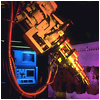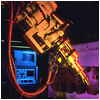
A factory stands in disrepair. By the late 1970s, economic changes turned America’s industrial area into the "Rust Belt."
Photo from James Jeffery Higgins.
The Rust Belt
The "Rust Belt" is the name given to the part of the United States that includes the Midwestern states of Illinois, Indiana, Michigan, and Ohio, as well as Pennsylvania. The name "rust belt" came from the fact that many industries in this region relied on outdated factories and technology. The term gained wide use in the 1970s as the once-dominant industrial region endured a period of economic decline as manufacturers, responding to global competition, relocated to other parts of the United States or Mexico. Factories closed, unemployment rose, and many working families left the region. Detroit, St. Louis, and Cleveland, as well as in smaller cities like Gary, Indiana, and Akron, Ohio are some examples of Rust Belt cities that have seen their urban centers decline. Detroit is still one of the world’s largest manufacturing centers but has been unable to reduce its dependence on the manufacturing sector as manufacturing jobs have declined. By the 1980s, the economy of some Rust Belt cities improved noticeably after the introduction and expansion of non-manufacturing industries. From the 1950s through the early 1980s, Pittsburgh was devastated by the cutbacks in the steel industry. More recently, it has reinvented itself as a center for research and development and finance.
|

